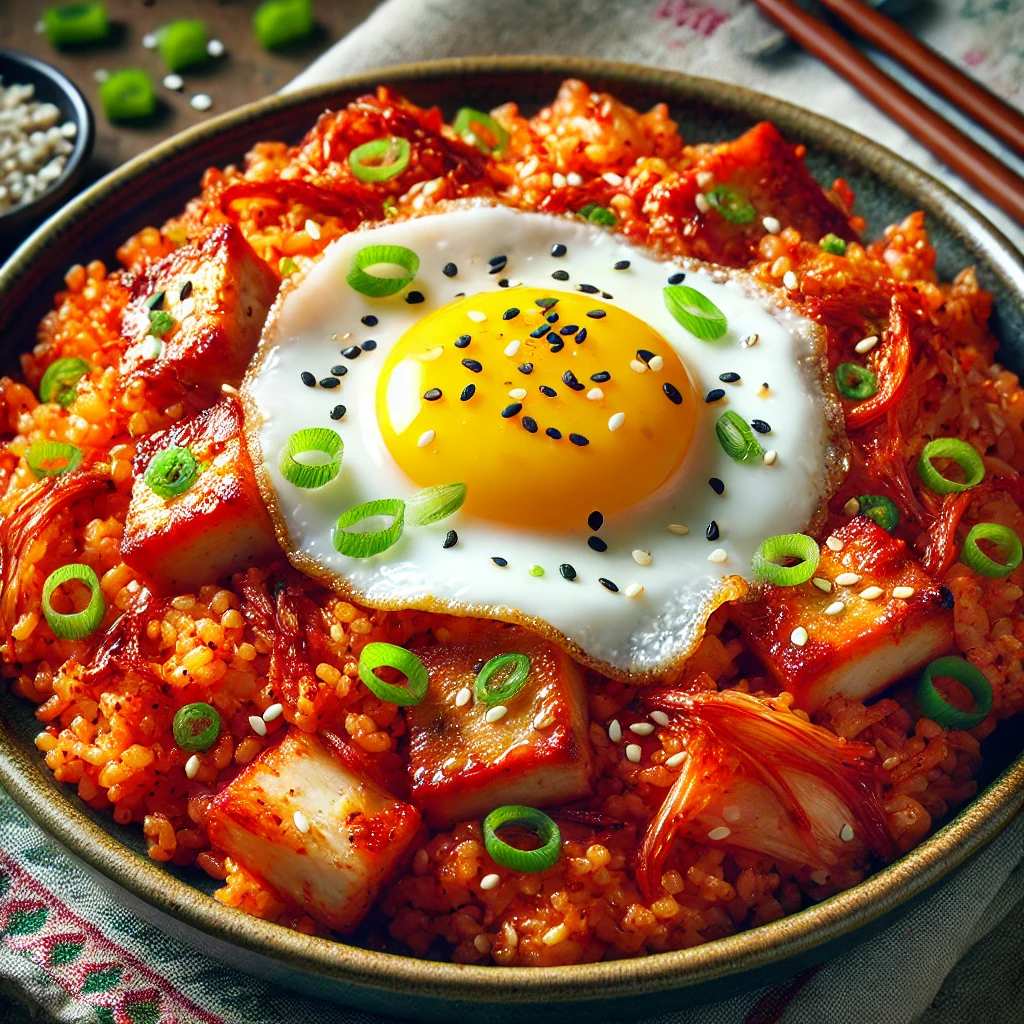Kimchi Bokkeumbap (김치볶음밥), or Kimchi Fried Rice, is the ultimate comfort food in Korean cuisine. It’s a simple yet incredibly satisfying dish that transforms leftover rice and kimchi into a flavorful, spicy meal that’s packed with umami. What makes this dish so appealing is its versatility—you can add various ingredients to customize it, like pork, beef, tofu, or a fried egg on top for extra richness.
Kimchi Bokkeumbap is perfect for a quick lunch, an easy weeknight dinner, or when you’re looking to use up that kimchi in the fridge. The tangy, spicy flavor of the kimchi, combined with the savory rice and optional toppings, creates a hearty dish that is beloved in Korean households and across the globe.
What is Kimchi Bokkeumbap?
At its core, Kimchi Bokkeumbap is fried rice made with kimchi (fermented Korean cabbage) and rice. The dish is stir-fried in a pan with the addition of aromatics like garlic and onions, and sometimes includes meat like pork belly or beef for added depth. The aged kimchi, which has become tangy and fermented, infuses the rice with its rich flavor, making this dish bold, tangy, spicy, and a little sweet.
The beauty of Kimchi Bokkeumbap lies in its simplicity and flexibility. It’s a go-to dish for using up leftover rice and kimchi, and you can add other ingredients you have on hand, such as tofu, vegetables, or a fried egg, to make it a complete meal.
The History of Kimchi Bokkeumbap
Like many fried rice dishes around the world, Kimchi Bokkeumbap was likely born out of the need to use leftover rice and kimchi. In Korean households, it’s common to have both rice and kimchi as everyday staples, and Kimchi Bokkeumbap offers a delicious way to repurpose them into a new meal.
Over the years, this humble dish has become a comfort food classic, often eaten at home, in casual eateries, and even as a popular late-night snack. Its quick preparation time and bold flavors make it a favorite among Koreans and international food lovers alike.
Key Ingredients: The Heart of Kimchi Bokkeumbap
While Kimchi Bokkeumbap can be made with just a few basic ingredients, the dish becomes extra special with the right mix of flavors and textures:
- Kimchi: The star of the dish. Aged kimchi is ideal for Kimchi Bokkeumbap because it has a more developed, tangy flavor that infuses the rice. The spicy, sour notes of the kimchi give the dish its signature taste.
- Rice: Leftover, cold rice works best for this dish. The slightly drier texture helps the rice fry up nicely without becoming mushy. Short-grain rice is typically used, but any leftover rice will do.
- Gochujang (Korean Red Chili Paste): For those who like extra heat, a spoonful of gochujang adds depth and spice to the fried rice. It also intensifies the umami and creates a richer flavor.
- Pork Belly or Spam: Pork belly, thinly sliced and stir-fried, is often added for extra richness and flavor. Spam is also a popular addition in Korea, bringing a salty, savory element to the dish.
- Egg: A fried egg on top of Kimchi Bokkeumbap is a must for many. The runny yolk adds a creamy texture that balances the spiciness of the dish.
- Green Onions: Chopped green onions add freshness and a little crunch, enhancing the dish’s flavor and presentation.
- Sesame Oil and Sesame Seeds: A drizzle of sesame oil at the end adds a nutty aroma, while sesame seeds sprinkled on top provide a crunchy texture and extra flavor.
How to Make Kimchi Bokkeumbap at Home
Kimchi Bokkeumbap is a quick and easy dish that you can whip up in less than 20 minutes. Here’s a simple recipe that you can customize to your liking:
Ingredients:
- 1 cup kimchi, chopped (with kimchi juice)
- 2 cups leftover cooked rice (cold)
- 100g pork belly or Spam, diced (optional)
- 2 tbsp gochujang (optional for extra spice)
- 1 small onion, chopped
- 2 garlic cloves, minced
- 2 tbsp soy sauce
- 1 tbsp sesame oil
- 1 tbsp vegetable oil (for frying)
- 2 eggs (fried sunny-side-up, for serving)
- Chopped green onions and sesame seeds for garnish
Instructions:
- Prepare the Ingredients: Chop the kimchi, and if using pork belly or Spam, dice it into small pieces.
- Stir-Fry the Pork: In a large pan or skillet, heat the vegetable oil over medium heat. Add the diced pork belly or Spam and stir-fry until browned and crispy. Remove from the pan and set aside.
- Sauté the Aromatics: In the same pan, add the minced garlic and chopped onions. Stir-fry until fragrant and the onions become translucent, about 2-3 minutes.
- Add the Kimchi and Gochujang: Add the chopped kimchi and a spoonful of gochujang (if using). Stir-fry for another 3-4 minutes, allowing the kimchi to soften and release its juices. The gochujang will deepen the flavor and give the dish a fiery kick.
- Fry the Rice: Add the leftover rice to the pan, breaking it up with a spatula. Stir-fry everything together, mixing the rice thoroughly with the kimchi and seasonings. Add soy sauce and stir to coat the rice evenly.
- Finish with Sesame Oil: Once the rice is hot and slightly crispy in places, drizzle the sesame oil over the top and give it a final stir.
- Serve with Fried Eggs: Divide the Kimchi Bokkeumbap into bowls, top each serving with a fried egg, and garnish with green onions and sesame seeds. The runny yolk from the egg will add a rich, creamy texture to the spicy rice.
Variations of Kimchi Bokkeumbap
There are many ways to customize Kimchi Bokkeumbap, making it a versatile dish that suits different tastes and dietary preferences:
- Vegetarian Kimchi Bokkeumbap: Skip the pork belly or Spam and use tofu or extra vegetables like mushrooms, zucchini, or bell peppers for a vegetarian version.
- Cheese Kimchi Bokkeumbap: Melt some mozzarella or cheddar cheese on top of the rice for a rich, creamy twist. The cheese balances out the spiciness of the kimchi.
- Seafood Kimchi Bokkeumbap: Add shrimp, squid, or other seafood to the dish for a briny, oceanic flavor.
Nutritional Benefits of Kimchi Bokkeumbap
Kimchi Bokkeumbap isn’t just delicious—it’s also packed with nutrients. Kimchi is a fermented food, rich in probiotics that support gut health and digestion. It’s also a good source of vitamins A, B, and C. When combined with protein (like pork or eggs) and fiber from the vegetables, this dish provides a balanced, satisfying meal.
Additionally, sesame oil contains healthy fats and antioxidants, while garlic and green onions offer anti-inflammatory and immune-boosting properties.
The Comfort of Kimchi Bokkeumbap
Kimchi Bokkeumbap is more than just a quick meal—it’s a comfort food that many Koreans grow up eating. It’s often associated with home-cooked meals and the practicality of using up leftovers in a way that still tastes delicious. Whether it’s a meal prepared on a busy weeknight or something whipped up after a long day, Kimchi Bokkeumbap brings comfort, warmth, and satisfaction.
Conclusion
Kimchi Bokkeumbap is the perfect example of how simple ingredients can come together to create something flavorful, comforting, and satisfying. Whether you’re a seasoned Korean food lover or trying it for the first time, this dish offers a taste of Korea’s bold flavors in an easy-to-make, customizable format. With its combination of spicy, savory, and slightly tangy notes, Kimchi Bokkeumbap is sure to become a favorite in your kitchen.






